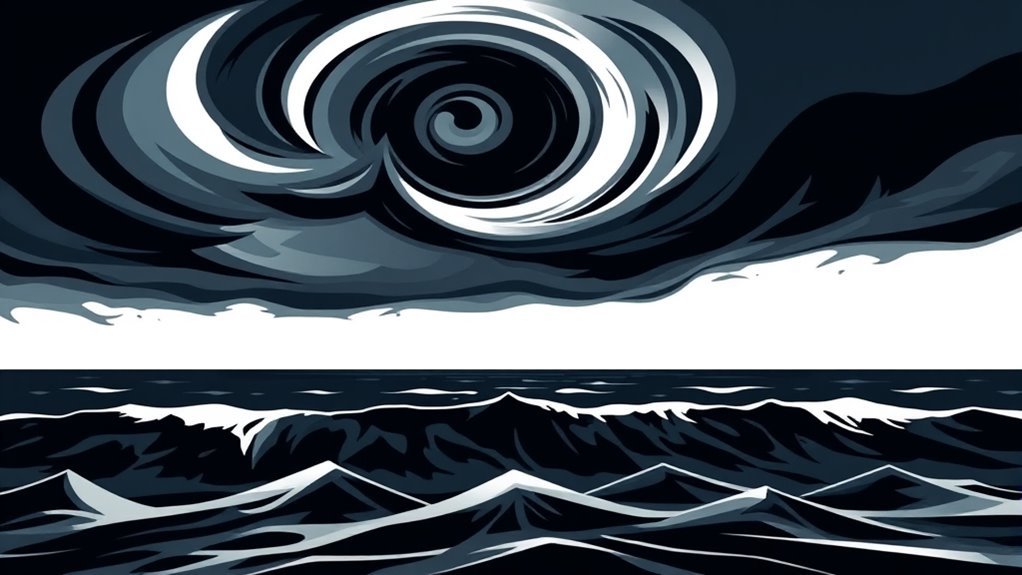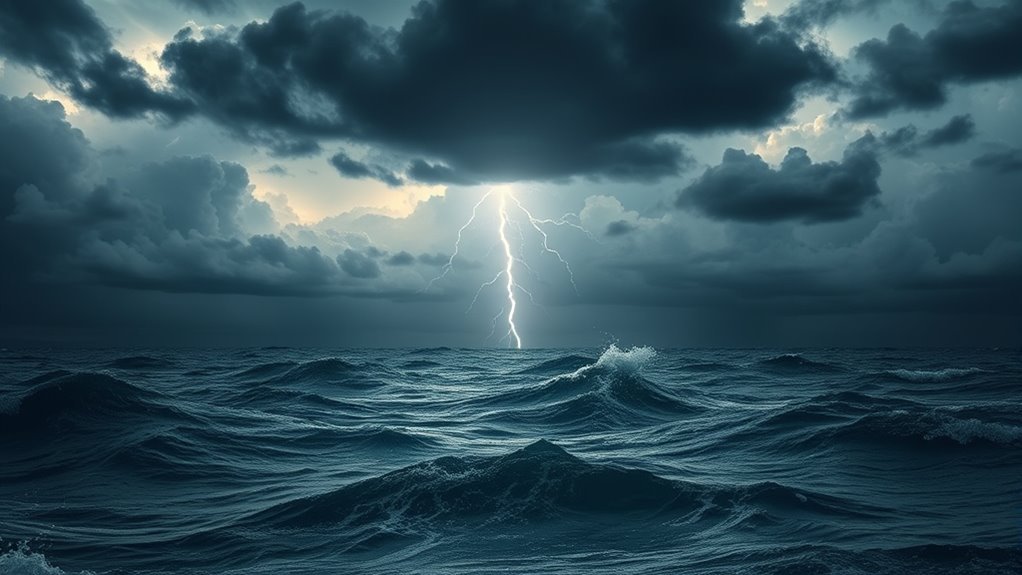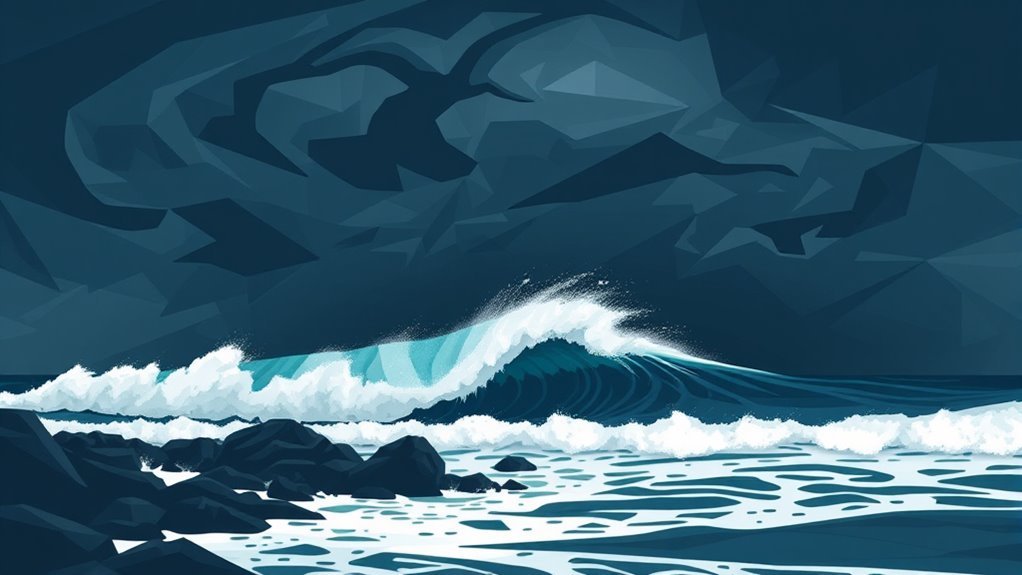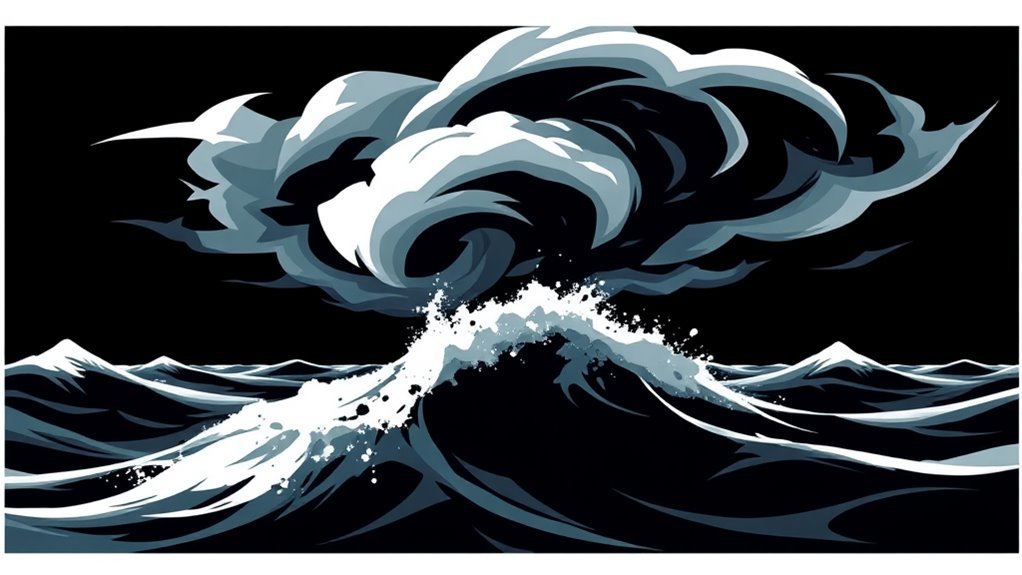Squalls play a critical role in intensifying large-scale weather disasters. These sudden bursts of wind and rain can cause rapid temperature changes and exacerbate flooding conditions. The intense wind can destabilize the atmosphere, contributing to severe storms. Additionally, squalls complicate forecasting due to their unpredictable nature. Their localized effects can lead to sudden impacts on communities already facing large-scale disasters. Understanding these dynamics reveals important revelations into the challenges of weather prediction and disaster preparedness.
Main Points
- Squalls can lead to sudden wind and rain, exacerbating flooding during large-scale weather disasters.
- Their rapid development complicates forecasting, resulting in unprepared communities during severe weather events.
- Intense rainfall from squalls can overwhelm drainage systems, increasing flood risks in urban areas.
- Squalls contribute to severe thunderstorm formation, which can escalate the severity of weather disasters.
- Climate change is linked to increased squall activity, potentially heightening the impact of future weather disasters.
Understanding Squalls: Definition and Characteristics
Squalls represent sudden, intense bursts of wind and rain, often accompanied by a rapid change in weather conditions. These phenomena can occur unexpectedly, leading to noteworthy disruptions in both natural and human environments.
Characteristically, squalls are short-lived but can produce powerful gusts that exceed 30 knots, creating hazardous conditions for maritime activities and aviation. The accompanying rainfall can be heavy, resulting in reduced visibility and potential flooding in vulnerable areas.
Squalls typically manifest as part of larger storm systems, often emerging from the leading edge of cold fronts or associated with thunderstorms. Their unpredictable nature complicates forecasting, making it essential for those in affected regions to remain vigilant.
While squalls may last only a few minutes to an hour, their impact can be deep, contributing to larger weather disasters and posing risks to safety and infrastructure. Understanding these characteristics is crucial for effective weather preparedness and response strategies.
The Formation of Squalls: Meteorological Processes

Understanding the meteorological processes behind squalls reveals the complex dynamics at play in their formation.
Squalls typically arise from the interaction of warm, moist air and cooler air masses. When warm air is forced upwards, often due to frontal boundaries or terrain, it cools and condenses, forming cumulonimbus clouds. This process generates considerable instability in the atmosphere, leading to the development of strong wind patterns.
The convection currents created can intensify rapidly, resulting in squall lines that manifest as intense thunderstorms. Additionally, environmental factors such as wind shear and atmospheric pressure variations contribute to the complete strength and duration of the squall.
As these elements converge, they create a potent weather phenomenon defined by brief but severe conditions, including heavy rainfall and strong gusts. Understanding these processes provides insight into the potential for squalls to escalate into larger weather systems.
Squalls and Their Impact on Local Weather Patterns
Squalls considerably alter local weather patterns through their localized wind effects and precipitation intensification.
These sudden bursts of wind can lead to abrupt changes in temperature and humidity, impacting nearby areas.
Additionally, the intense rainfall associated with squalls can exacerbate flooding and disrupt established weather systems.
Localized Wind Patterns
When intense differences in temperature and pressure occur within a localized area, dramatic wind patterns known as squalls can develop, greatly influencing local weather conditions.
These squalls are defined by sudden and brief increases in wind speed, often accompanied by turbulent gusts. The formation of squalls can lead to rapid shifts in wind direction, creating localized weather phenomena.
This change can disrupt established weather patterns, enhancing the effects of existing systems. Additionally, squalls can contribute to the mixing of air layers, which may further alter local temperature profiles.
As a result, the influence of squalls can extend beyond their immediate vicinity, affecting broader meteorological dynamics and complicating weather forecasting efforts.
Understanding these localized wind patterns is essential for predicting severe weather events.
Precipitation Intensification Effects
As localized wind patterns intensify, they can markedly boost precipitation levels, leading to a multitude of effects on local weather.
Squalls, defined by sudden and intense bursts of wind, can cause localized rainfall to intensify, often resulting in flash flooding and erosion. The abrupt changes in atmospheric pressure associated with these squalls can disrupt established weather patterns, leading to unexpected weather phenomena in nearby areas.
In addition, increased precipitation from squalls can improve soil moisture levels, impacting agriculture and natural ecosystems. While beneficial in some contexts, these intensified precipitation events can also strain infrastructure and emergency services.
Understanding the dynamics of squalls and their precipitation effects is essential for predicting and managing the ramifications of severe weather events.
The Connection Between Squalls and Severe Storms

Severe storms frequently manifest in conjunction with squalls, highlighting a substantial connection between these phenomena.
Squalls, defined by sudden and intense wind shifts, often precede or accompany severe weather events, enhancing their intensity and destructive potential. Understanding this relationship is essential for meteorologists and disaster preparedness.
Key aspects of this connection include:
- Rapid Wind Changes: Squalls can introduce sharp shifts in wind direction and speed, contributing to the formation of severe thunderstorms.
- Enhanced Instability: The turbulent air associated with squalls can destabilize the atmosphere, leading to increased convective activity.
- Intensified Precipitation: Squalls often bring heavy rainfall, which can exacerbate flooding conditions during severe storms.
- Lightning Activity: The dynamic nature of squalls can increase the likelihood of lightning strikes, posing additional risks to affected areas.
These factors underscore the need for vigilant monitoring of squall activity in relation to severe weather forecasts.
Case Studies: Squalls in Notable Weather Disasters

The examination of historical squall events reveals their important role in various weather disasters.
Remarkably, the interplay between squalls and hurricanes has led to increased intensity and destruction in affected areas.
Additionally, understanding the connection between squalls and tornado formation can provide critical perspectives into storm dynamics and safety measures.
Historical Squall Events
Squalls have historically played a vital role in shaping weather-related disasters, often acting as catalysts for notable events.
These intense bursts of wind and rain have contributed to considerable instances of destruction throughout history.
Some notable historical squall events include:
- Hurricane Katrina (2005) – Squalls intensified the storm's impact, leading to catastrophic flooding in New Orleans.
- The Great Galveston Hurricane (1900) – Squalls contributed to the hurricane's sudden intensification, resulting in over 8,000 fatalities.
- Tropical Storm Allison (2001) – Squalls exacerbated rainfall, causing unmatched flooding in Houston and surrounding areas.
- The 1970 Bhola Cyclone – Squalls played a vital role in the storm's rapid intensification, leading to one of the deadliest natural disasters in history.
These events illustrate the dangerous potential of squalls in large-scale weather disasters.
Squalls and Hurricane Impact
How do squalls influence the devastation caused by hurricanes?
Squalls, defined by sudden and intense bursts of wind and rain, can exacerbate the already catastrophic impacts of hurricanes. For instance, during Hurricane Katrina in 2005, squalls contributed to widespread flooding and amplified wind damage, complicating rescue efforts.
Similarly, Hurricane Harvey in 2017 saw squalls leading to record-breaking rainfall, overwhelming drainage systems and causing severe urban flooding. These intense weather phenomena can extend the reach of hurricanes, influencing areas far from the storm's eye.
In both cases, squalls not only intensified the immediate effects of the hurricanes but also prolonged recovery challenges, highlighting the critical role squalls play in the comprehensive devastation of large-scale weather disasters.
Tornado Formation Connection
Although often overlooked, the connection between squalls and tornado formation in notable weather disasters is substantial.
Research indicates that squalls can create the necessary atmospheric instability and wind shear conducive to tornado development. Several case studies highlight this link:
- 2011 Joplin Tornado – A squall line contributed to the formation of one of the deadliest tornadoes in U.S. history.
- 2013 Moore Tornado – Conditions associated with a squall system intensified the tornado's strength and path.
- 1974 Super Outbreak – Multiple squalls produced numerous tornadoes across several states in a single day.
- 2019 Alabama Tornadoes – A squall line was identified as a triggering factor for the formation of destructive tornadoes.
These examples underscore the critical role squalls play in exacerbating severe weather events.
Forecasting Squalls: Challenges and Techniques
What makes forecasting squalls particularly challenging lies in their rapid development and the localized nature of their impacts. Squalls can form suddenly, often with little warning, complicating traditional forecasting methods that rely on longer-term atmospheric patterns. Their intensity can vary considerably over short distances, making it difficult for meteorologists to predict where the most severe effects will occur.
Advanced weather models and satellite imagery have advanced squall forecasting, yet discrepancies still arise due to the complex interactions within weather systems. High-resolution simulations are essential, allowing forecasters to capture the fine-scale phenomena that lead to squall formation.
Additionally, real-time data from weather radars can improve situational awareness, but challenges remain in disseminating timely and accurate warnings to affected communities. As squall activity intensifies with climate change, refining forecasting techniques remains a critical area of research in meteorology.
Preparing for Squalls: Mitigation and Safety Measures
Effective preparation for squalls is essential for minimizing their potentially devastating impacts on communities. Individuals and local authorities must adopt proactive measures to improve safety and resilience. Key strategies include:
- Emergency Kits: Assemble thorough emergency kits containing essentials like water, non-perishable food, first-aid supplies, and flashlights to guarantee readiness during squall events.
- Community Awareness Programs: Implement educational initiatives to inform residents about squall characteristics, warning signs, and safety protocols, nurturing a culture of preparedness.
- Infrastructure Reinforcement: Invest in strengthening infrastructure, such as flood barriers and drainage systems, to mitigate the adverse effects of sudden squall-induced flooding.
- Monitoring and Communication Systems: Establish reliable weather monitoring and communication systems to provide timely alerts, enabling communities to respond swiftly to impending squalls.
Common Questions
How Do Squalls Differ From Regular Thunderstorms?
Squalls are intense, short-lived weather events defined by sudden wind shifts and heavy precipitation, differing from regular thunderstorms, which typically have longer durations and more gradual onset of rain and wind, leading to varied impacts.
Can Squalls Occur in Winter Weather Conditions?
Squalls can indeed occur during winter weather conditions. These sudden, intense bursts of wind and precipitation may manifest as snow squalls, bringing reduced visibility and hazardous conditions, similar to their warm-weather counterparts, but with colder temperatures.
What Regions Are Most Prone to Squalls?
Regions most prone to squalls typically include coastal areas, particularly in the eastern United States, as well as parts of the Great Lakes and the Mediterranean. These regions experience conditions conducive to sudden, intense storms.
Are Squalls Predictable Days in Advance?
Squalls can be challenging to predict days in advance due to their sudden nature. Meteorologists often rely on short-term forecasting models, which may provide some insight but lack the precision for extended forecasts.
What Safety Gear Is Essential During a Squall?
Essential safety gear during a squall includes a life jacket, waterproof clothing, sturdy footwear, and a reliable flashlight. Additionally, having a whistle, first-aid kit, and emergency communication apparatus guarantees preparedness for unpredictable weather conditions.

